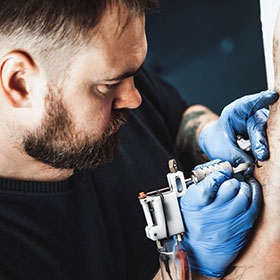Do leg tattoos hurt? The short answer is yes, they can.
Pain levels vary for each person. Getting a tattoo involves needles piercing the skin. Naturally, this causes some discomfort. The pain you feel depends on several factors. These include your pain tolerance, the tattoo’s size, and its placement on your leg.
Some areas may hurt more, like near bones or joints. For many, the beauty of a tattoo outweighs the pain. Understanding what to expect can help you decide if a leg tattoo is right for you. Keep reading to learn more about the pain involved and how to manage it.
Introduction To Leg Tattoos
Leg tattoos are very popular today. Many people choose them for their unique look. Legs offer a large canvas for detailed designs. Tattoo artists love working on legs. The skin is often smooth and easy to ink. Leg tattoos can be hidden or shown off easily. This makes them a flexible choice.
Leg tattoos have grown in popularity. Celebrities often display their leg tattoos. Social media also boosts their appeal. Photos of leg tattoos get many likes and shares. This trend inspires others to get their own leg tattoos. Designs can be very creative and personal. Many people enjoy the freedom of expressing themselves through leg tattoos.
Legs provide a large area for tattoos. This allows for bigger, more detailed designs. Some people choose leg tattoos to cover scars. Others like them because they can be hidden under clothes. The pain level is often moderate. This makes leg tattoos a good choice for beginners. Many people find leg tattoos a great way to show their personality.
Pain Factors In Leg Tattoos
Leg tattoos can be painful, especially on the shin and calf due to less muscle and fat. Pain levels vary by individual and tattoo location.
Skin Sensitivity
The skin sensitivity on the leg can affect the pain level. Some areas have thinner skin, making them more painful to tattoo. The calf is usually less painful. The shin and ankle hurt more. Thicker skin areas are less sensitive to pain. Personal pain tolerance varies too. Everyone feels pain differently. Even the same person can feel pain differently on different days.
Location On The Leg
The location on the leg greatly impacts pain. Areas with less muscle and more bone feel more painful. The inner thigh is more sensitive compared to the outer thigh. The knee and ankle are also more painful spots. The calf muscle area is generally less painful. Pain also depends on how close the tattoo is to nerves. Closer to nerves, higher the pain.
Different Leg Areas And Pain Levels
Leg tattoos can hurt differently depending on the area. Calves and thighs often hurt less, while shins and ankles can be more painful. Pain levels vary from person to person.
Thighs
The thighs usually have more flesh. This makes them one of the least painful places for a tattoo. Some people say it feels like a scratch.
Calves
Calves have a good amount of muscle and fat. This area can be less painful than other parts. The pain is often bearable and feels like a dull ache.
Shins
Shins can be more painful. The skin is thin and close to bone. Many people describe the feeling as a sharp sting.
Ankles
Ankles can be very painful for tattoos. The skin here is very thin. There is not much cushion from bones. Most people feel a sharp, intense pain.
Pain Management Techniques
Topical anesthetics can help numb the skin. This reduces the pain felt during tattooing. These creams or gels are easy to apply. Follow the instructions on the packaging. Be sure to check with your tattoo artist before use. Some artists may prefer not to use them. Always perform a patch test to avoid allergic reactions.
Breathing techniques can help manage tattoo pain. Deep breaths keep you calm. This helps you focus on something else. Try to breathe in deeply through your nose. Hold for a few seconds. Then, slowly breathe out through your mouth. Repeat this several times during the tattoo session. It helps reduce stress and pain.
Tattoo Artist’s Role In Pain Management
A skilled tattoo artist can reduce pain. They know the best ways to work quickly. This means less discomfort for you. An experienced artist uses light pressure. This helps to avoid extra pain. They also use good quality equipment. Proper tools make a big difference.
Clients feel less pain with a good technique. An artist with many years of practice knows how to manage pain. They understand the skin and how to handle needles. This keeps the pain level low. Always choose an experienced artist for your tattoo.
Talking with your tattoo artist is key. Tell them your pain level. They can adjust their technique. This helps make the tattooing process smoother. Good communication builds trust. It makes the experience less scary.
A good artist will ask about your pain. They will check in often. This makes you feel safe. If you feel too much pain, tell them. They can take a break or change methods. Open communication helps manage pain better.
Personal Pain Tolerance
Every person feels pain differently. Some people have high pain tolerance. Others may feel more pain. Pain levels can change due to mood or tiredness. Your body’s unique. So, pain will vary.
Being prepared helps. Thinking positive thoughts can reduce pain. Relax before your tattoo. Deep breaths help calm you. Stay hydrated. Eat a good meal. These steps can ease your mind and body.
Recovery And Aftercare
Leg tattoos can be painful, especially on bony areas. Proper aftercare helps ensure quick healing and reduces discomfort. Keep the tattoo clean, moisturized, and follow your artist’s advice for the best results.
Immediate Aftercare
After getting a leg tattoo, the artist will wrap it. Leave the wrap on for a few hours. Wash the tattoo gently with mild soap and water. Pat it dry. Do not rub. Apply a thin layer of healing ointment. Repeat this process twice a day. Avoid soaking the tattoo. No swimming or baths. Showers are fine. Wear loose clothing to prevent rubbing.
Long-term Care
Keep the tattoo moisturized. Use unscented lotion. Avoid direct sunlight for a few weeks. Tattoos can fade in the sun. Use sunscreen once healed. Do not scratch or pick at scabs. This can cause infections. Stay hydrated and eat well. Your skin needs nutrients to heal. Check with your artist if you notice any issues.
Real Experiences From Tattoo Enthusiasts
Many people share their leg tattoo stories. Some felt a sharp pain at first. Others said the pain was like a scratch. The pain level can vary. It depends on the person and the spot on the leg. The area near the bone may hurt more. Some said it was a dull ache. It felt like a burn or sting.
Start with a small tattoo. It helps you see your pain level. Stay calm and breathe deeply. Bring a friend for support. Choose an experienced artist. They know how to make the process smoother. Drink water and eat well before your session. This helps you feel strong and less dizzy. Wear comfortable clothes. It makes the session easier.
Conclusion
So, do leg tattoos hurt? Yes, but pain varies by person. Placement and size affect discomfort levels. Choose a skilled tattoo artist for a better experience. Prepare mentally and physically. Listen to your body during the process. Remember, the pain is temporary.
The beautiful tattoo is forever. Always care for your new tattoo properly. This reduces pain and ensures it heals well. Ready for a leg tattoo? Now you know what to expect. Make an informed decision and enjoy your new artwork!

